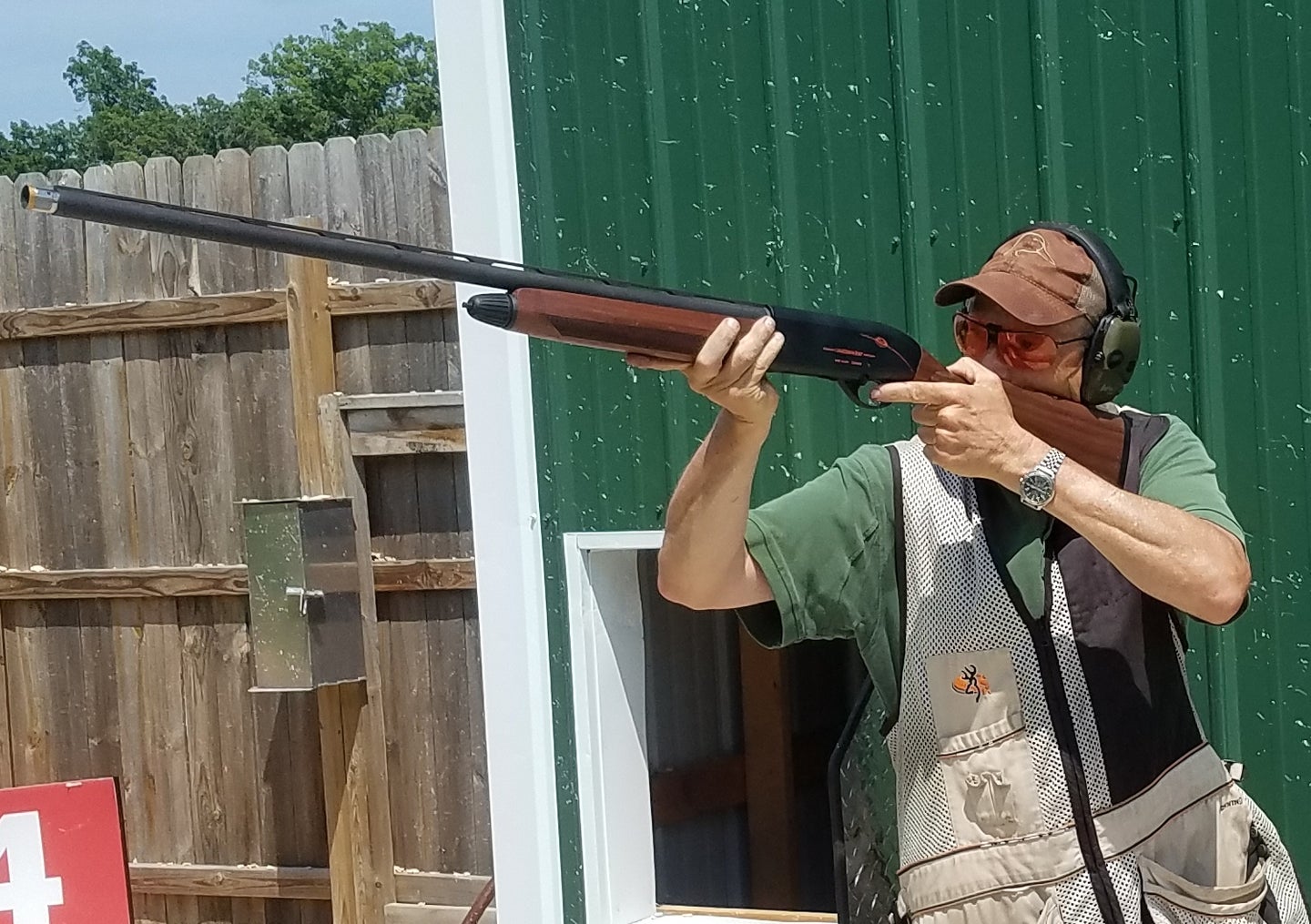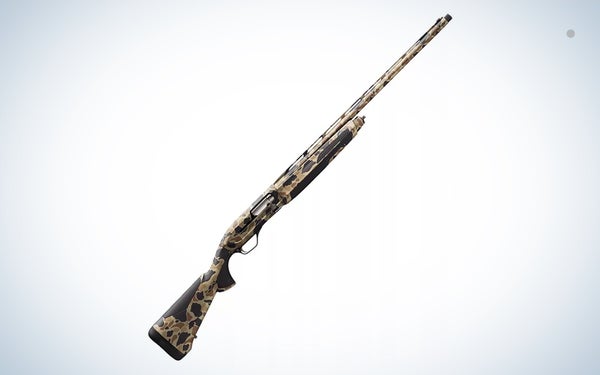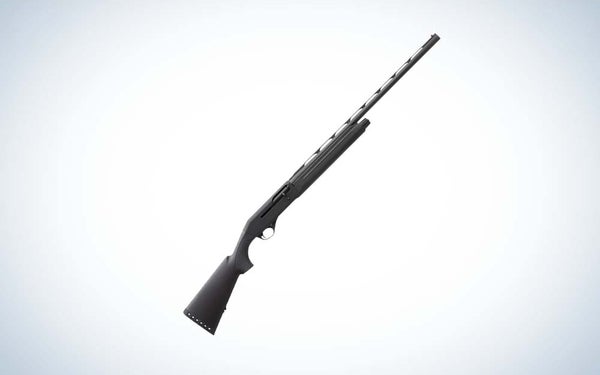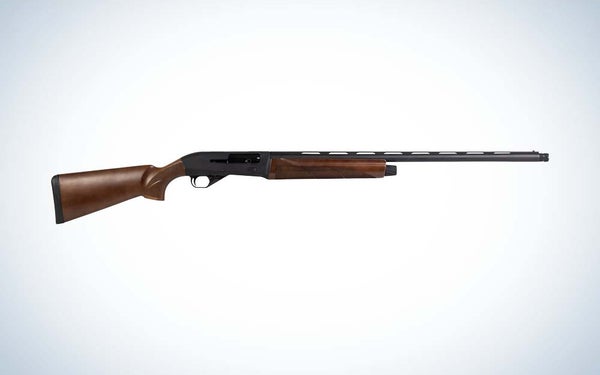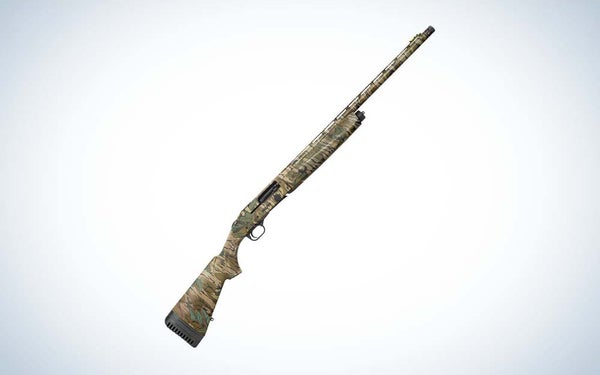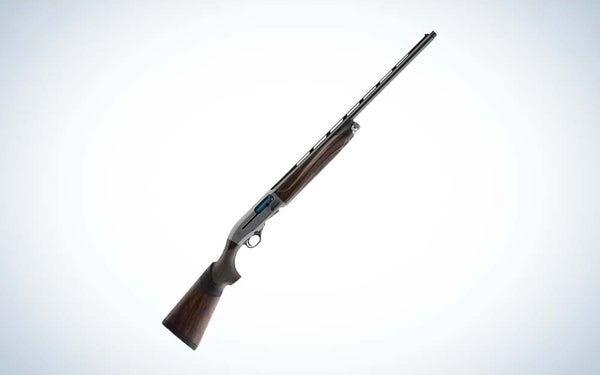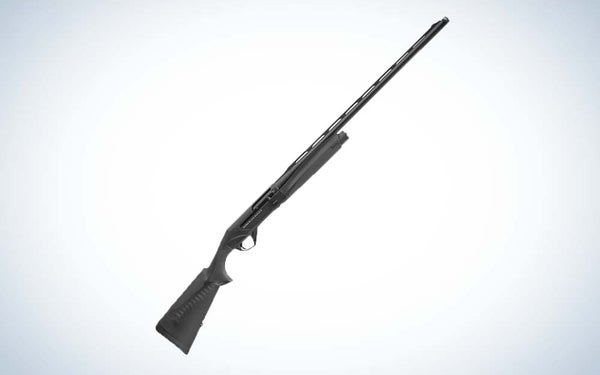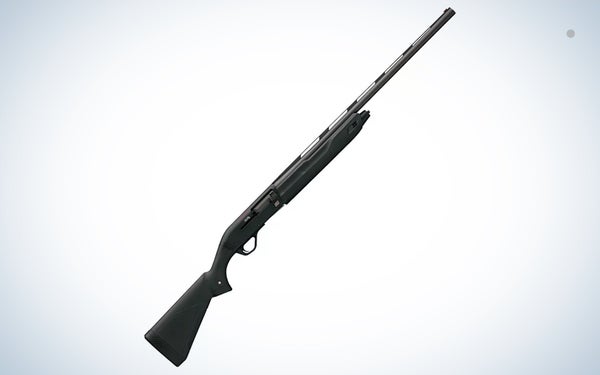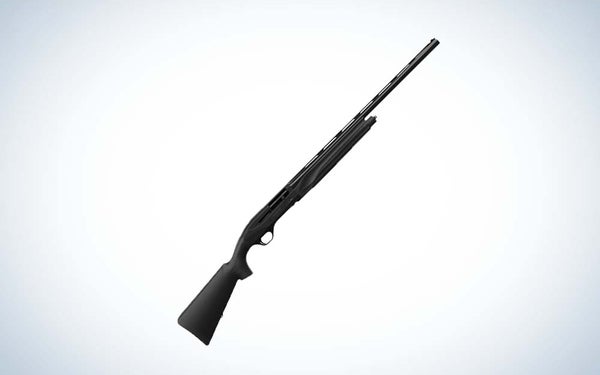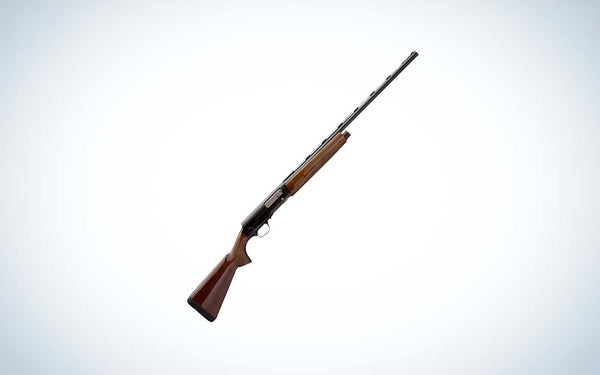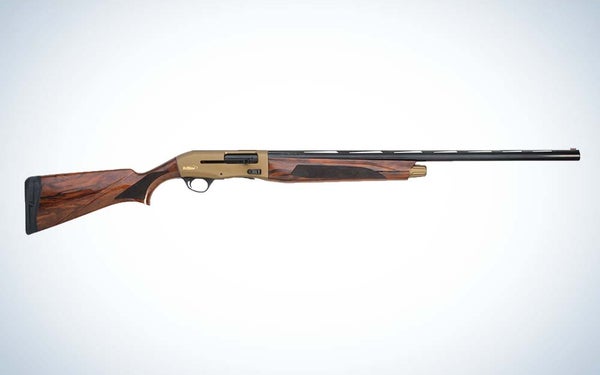| Best Overall |
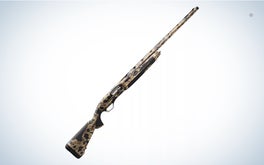
|
Browning Maxus II | SEE IT |
LEARN MORE
|
Summary
The Maxus II is soft-shooting, versatile, light enough to carry, heavy enough to shoot, and made to be easily shortened. |
| Best for Sporting Clays |
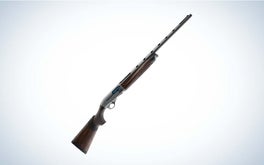
|
Beretta A400 Xcel | SEE IT |
LEARN MORE
|
Summary
By far the most popular semi-auto among serious clay competitors, the A400Xcel is the latest and softest-shooting Beretta yet. |
| Best Upland Shotgun |

|
Browning A5 Sweet 16 | SEE IT |
LEARN MORE
|
Summary
There’s nothing like the Sweet 16 on the market. A lightweight, inertia-operated 16 gauge that harkens back to a traditional favorite, the Sweet 16 A5 is a modern classic. |
We may earn revenue from the products available on this page and participate in affiliate programs. Learn more ›
Semi-automatic shotguns shoot more reliably than ever before. They aren’t finicky about ammunition, and they will shoot for a long time in-between cleanings. The fact that semi-autos have become the primary gun among waterfowlers tells you all you need to know about the semi-auto’s reliability in tough conditions. That doesn’t mean semi-autos are made only for duck hunting. They fit right into upland hunting, target shooting, turkey hunting, and home defense as well. There are a lot of choices out there, and a 12-gauge semi-automatic shotgun can handle almost any shooting chore.
There are also two main types of semi-automatic shotguns to choose between: gas-operated guns, which have the advantage of reduced recoil at the cost of a little more maintenance, and inertia guns, which stay cleaner, longer. But what semi-automatic shotgun is right for you? I’ve compiled a list of the best semi-automatic shotguns to help guide your selection.
- Best Overall: Browning Maxus II
- Best Budget Inertia Gun: Stoeger m3000
- Best Budget Gas Gun: CZ 712 G3
- Best Dedicated Turkey Gun: Mossberg 940 Turkey Pro
- Best for Sporting Clays: Beretta A400 Xcel
- Best Waterfowl Gun: Benelli SBE3 BE S.T.
- Best Value Gas Gun: Winchester SX4
- Best Value Inertia Gun: Retay Gordion
- Best Upland Shotgun: Browning A5 Sweet 16
- Best .410 Shotgun: TriStar Viper G2 Pro
How We Picked the Best Semi-Automatic Shotguns
When evaluating the current crop of semi-automatics, I brought a lifetime of shooting autoloaders at birds and targets to the task. Since the first question people always ask about a semi-auto is, “have you had any problems with it?” reliability and the ability to shoot a range of ammunition were among the top criteria. After that, we looked at ergonomics, which has received extra attention from manufacturers lately, and weight, balance, and handling.

Best Semi Automatic Shotguns: Reviews & Recommendations
Best Overall: Browning Maxus II
Specs
- Weight: 7 pounds, 2 ounces
- Gauge: 3- and 3 ½-inch 12 gauge
- Operation: Gas
Pros
- Soft cheek- and butt-pads plus gas system produce soft recoil
- Stock made to be easily shortened
- Browning Speed-Load feature for fast reloads
Cons
- 12 gauge only
The Maxus II represents the next generation of Browning gas guns, building on the success of the Gold and the original Maxus. The result is a very reliable, soft-kicking gun with several good ergonomic features. The addition of a soft rubber insert in the gun’s comb does a remarkable job of reducing the gun’s already mild recoil. The redesigned stock features a parallel section at the butt so that the stock can be shortened without the need to regrind or replace the original recoil pad. The stock comes with a shim kit to fine-tune fit, and the safety can be switched from right to left-handed in a couple of minutes.
The gun also has an enlarged bolt handle and bolt release button found on many new semi-autos. Combined with Browning’s unique Speed Load that grabs a shell thumbed halfway into the magazine and whisks it into the chamber, as well as a magazine plug that is easily removed and replaced with no tool other than a key, the Maxus II is one of the most user-friendly shotguns around. And, it shoots flat to the point of aim and has an overbored barrel and long choke tubes to improve patterning. It’s a gun you can take from the goose pit to the dove field to the sporting clays course with total confidence.
Best Budget Inertia Gun: Stoeger m3000
Specs
- Weight: 7 pounds, 2 ounces (12 gauge)
- Gauge: 3-inch 12 gauge (20 gauge Model m3020 and 3 ½-inch 12 m3500 also available)
- Operation: Inertia
Pros
- Lightweight
- Enlarged bolt handle and release
- Action spring on magazine tube instead of in stock simplifies cleaning
Cons
- Fit and finish only fair
- Recoil
These inertia guns are made in Turkey by Stoeger, a company now owned by inertia-gun innovator Benelli. Made to an entry-level standard of fit and finish, the m3000 is priced so almost anyone can afford it. Having been in production since 2001, they have a long track record and are durable and affordably priced.
The main difference in action between the Stoeger and a Benelli is that the m3000 has the action spring that returns the bolt to the battery around the magazine tube, not in the stock, so it is easy to inspect and clean. The spring up front does make the gun’s forend bulkier and gives it a weight-forward balance that feels awkward, but swings well. It also has a semi-humpback receiver profile that sets it apart from a Benelli.
This year the whole Stoeger inertia lineup received a makeover with a larger bolt handle, closer button, and a bigger, triangular safety, as well as milled-out loading port, all to facilitate easier reloads. The new additions make the gun an even better value. The m3000 cycles target loads down to 1 ⅛ ounces well. The bottom line is, if you want an inertia gun that may not be a Benelli but costs a third as much, the m3000 is for you.
Best Budget Gas Gun: CZ 712 G3
Specs
- Weight: 7.3 pounds
- Gauge: 3-inch 12-gauge
- Operation: Gas
Pros
- Turkish walnut stock
- Shoots a wide variety of ammunition
- Comes with extras like shims and extended chokes
Cons
- User must switch gas pistons for shooting light and heavy loads
CZ brings back its 712 gas semi-auto with a new, sleeker receiver profile and the enlarged safety, bolt handle, bolt release, and bolt lock buttons that shooters now demand. The Turkish-made gas gun has a matte-finished alloy frame and barrel and satin-finished Turkish walnut stock and forend. This makes it a gun you can take to the range, the uplands, and to a duck blind or turkey woods, where the matte finish won’t shine and spook game. With both stock shims to adjust fit and extended tubes, the gun does come with a lot of extras for such a low price. The trade-off for this excellent value in a gas gun is that, unlike other designs, this one doesn’t shoot all loads without adjustment. It comes with two different gas pistons, one for light loads and one for heavy loads. Switching pistons is only a matter of unscrewing the magazine cap, pulling off the barrel, sliding off the old piston, and putting the new one on. Nevertheless, it’s outdated technology, but it makes terrific savings possible.
Best Dedicated Turkey Gun: Mossberg 940 Turkey Pro
Specs
- Weight: 7.25 pounds
- Gauge: 3-inch 12-gauge
- Operation: Gas
Pros
- Short barrel for ease of use in the woods
- Receiver cut is unique to Mossberg and positions eye in perfect sight alignment
- Cool old-school Mossy Oak Green Leaf finish
Cons
- Takes 3-inch shells, not the 3 ½-inch that some hunters prefer for turkeys
The 940 is an improved, more reliable version of the 930. With input from pro shooter Jerry Miculek, Mossberg redesigned the gas buffer tube and boron-nitride-coated internal parts. The 940 runs much more reliably than its predecessor. The Turkey Pro features a choice of a 24-inch or an 18.5-inch barrel for lighter weight and maneuverability in the brush, although perhaps at the expense of pattern density vs the longer barrel. In either case, the gun comes with Mossberg’s X-Factor choke tube for tight patterns with turkey loads.
While it has the enlarged bolt handle and release button that are popular on semi-autos now, there is rarely a need for fast reloading in the turkey woods. On the other hand, the cut milled in the alloy receiver for red dot mounting is a huge bonus to turkey hunters who prefer an optic. Sized to fit a red dot sight with the RMSc Shield footprint, the cut allows you to mount the dot down low where it’s easy to use without lifting your head. The receiver is also drilled and tapped in case you prefer to mount a different sight or a scope. Another nice feature for turkey hunters is the removable spacers that enable you to reduce the length of pull to 13 inches, which is very convenient even for full-sized hunters when sitting down and leaning back against a tree. Finally, the gun is dipped in Mossy Oak Green Leaf camo for an effective and cool retro camo look.
Best Sporting Clays: Beretta A400 Xcel
Specs
- Weight: 7 ¾ pounds
- Gauge: 3-inch 12-gauge
- Operation: Gas
Pros
- Kick-off recoil reducer works very well
- Ultra-reliable
- Easy to clean
- Comes in a model stocked for women, too
Cons
- Only comes in 12-gauge
Look around at any major sporting clays shoot. If a competitor is shooting a semi-auto, it’s a Beretta. No one makes target semi-autos like Beretta does, and the recently redesigned A400 Xcel does away with the one feature that turned off some shooters: the bright blue receiver. Now it’s finished in more discreet silver, with a blue bolt. More importantly, the gun features an improved version of the already very effective Kick-Off recoil reducing system. The Kick-Off, combined with the A400 Xcel’s gas system, makes this the gun with the least recoil on the market. Beretta also bills the A400 Xcel as the fastest semi-auto shotgun thanks to its “Blink” gas system. It can shoot five shells before the first empty hits the ground.
Berettas are legendary for their ability to run forever between cleanings, and when you do have to clean this gun, there’s not much to it by gas-gun standards. The piston is a simpler design than those of previous Beretta semi-auto pistons, with fewer nooks and crannies to hold carbon, the action spring is on the magazine tube where it is easy to reach, and the gas valve no longer has to be taken apart and cleaned.
The A400 Xcel cycles any target load, even very light reloads with unfailing reliability, and while the stock comes with shims to permit some adjustment, there is also a “Vittoria” version stocked for women. The gun is also available in a limited black receiver edition.
Best Waterfowl Gun: Benelli BE.S.T.
Specs
- Weight: 5.6 pounds (28-gauge) to 7 pounds (12-gauge)
- Gauges: 3 ½-inch 12-gauge, 3-inch 20-gauge, 3-inch 28-gauge
- Operation: Inertia
Pros
- Reliability
- Lightweight
- Great ergonomics
- Weatherproof coating
Cons
- Most expensive waterfowl gun on the market
Benelli made its name with the Super Black Eagle, the very first 3 ½-inch 12-gauge semi-auto. Their inertia guns earned a reputation for staying cleaner, longer, than gas guns, and for being reliable in the worst waterfowling weather. As the latest iteration of the famous Super Black Eagle line, the SBE3 with BE S.T. carries on with the company’s reputation for innovation. The BE S.T. stands for “Benelli Surface Treatment,” which is a very high-tech method of coating the guns in rustproof graphite.
The BE S.T. lineup comprises a 3 ½-inch 12, a 20-gauge, and one of the first 3-inch 28-gauges on the market. All the guns feature Benelli’s vibration-dampening ComforTech stock to reduce recoil, and the SBE3 is the first of the line to feature the Easy Locking bolt that eliminates the out-of-battery misfires you can experience with inertia guns. Each successive generation of SBE has been slimmer and lighter than the previous model, too, and they are a delightful gun to carry and shoot, even in 12-gauge.
Best Value Gas Gun: Winchester SX4
Specs
- Weight: 6 lbs 8 oz (20-gauge) to 7 lbs, 2 oz (12-gauge)
- Gauges: 3 ½-inch 12, 3-inch 12, 3-inch 20
- Operation: Gas
Pros
- Soft recoil
- Proven gas system
- Enlarged controls
Cons
- Feels cheaper than SX3
Winchester’s Super X line really started with SX2 in the 1990s as a gas gun based on the successful Gold made by sister company Browning. It used the same gas system, resulting in a soft-recoiling gun that was both simple to clean and quite reliable. The Super X3 followed. It was a lighter gun, and it had modern lines in place of the retro look of the X2. With the X4, Winchester cheapened the X3 with some plastic parts and was able to lower the price. It’s still the same excellent gun on the inside, but now priced at (for the 3 ½-inch gun) or below (3-inch 12- and 20-gauges) $1000. While you can spend less for a gas gun, you can also spend a lot more and not get anything extra for your money than the SX4 delivers.
The SX4 comes in black, camo, and walnut versions, all of which have both spacers and shims to help them fit a variety of shooters. There are also compact models available, a true, mirror-image left-handed model, and a dedicated turkey gun. All the guns feature enlarged bolt handles and release buttons and a big safety that is very easy to reverse for left-handed use. The guns also have overbored barrels and lengthened forcing cones for better patterning.
Best Value Inertia Gun: Retay Gordion
Specs
- Weight: 6 ¾ pounds in 12-gauge
- Gauges: 3-inch 12-gauge, 3-inch 20-gauge
- Operation: Inertia
Pros
- Well-made
- Inertia-Plus bolt won’t go out of battery
- Deep-drilled barrels
The Gordion is the lower-priced of Retay’s two inertia semi-autos, but gives up nothing in performance over the top-of-the-line Masai Mara. The barrels are deep-drilled, not hammer-forged, a more expensive process that assures the barrel will be straight, strong, and not stressed. The barrels are also bored with long forcing cones to improve patterns. While the barrel is the heart of a shotgun, Retay pays attention to the rest of the gun as well. The Inertia-Plus bolt can’t be bumped easily out of battery to cause a misfire, and its trigger guard is alloy, not plastic.
The Gordion is very lightweight at 6 ¾ pounds in 12 gauge, and while that makes it a pleasant gun to carry, light inertia guns can produce stout recoil with very heavy loads. Fortunately, there is no 3 ½-inch 12-gauge Gordion. The gun has pleasingly modern lines overall, and if you spend the extra $100 to step from a synthetic to a walnut-stocked model, the walnut you’ll receive is far above the grade you would expect on a semi-auto listing for $999. Walnut or synthetic, the Gordion compares very well with inertia guns costing much more.
Best Upland Semi-Auto: Browning A5 Sweet 16
Specs
- Weight: 5 ¾ pounds
- Gauge: 16
- Operation: Inertia
Pros
- Lightweight
- Classic lines
- Good recoil pad
Cons
- 16 gauge ammo selection is limited
With its squared-off receiver, the new A5 Sweet 16 evokes the classic Auto 5 Sweet 16, but this is an entirely new gun on the inside. It might even be a better gun than the original Auto 5, where the first Sweet 16 utilized the long-recoil system and a moving barrel, the new A5 Sweet 16 is an inertia gun. It’s much lighter than the original at under 6 pounds, and it’s a joy to carry on long days in the field. At the same time, it’s long enough and well-balanced enough to swing with some discipline.
The gun shares all the features of other Browning semi-autos that make them popular. The barrel is over-bored and has lengthened forcing cones for improved patterns, and it features Browning’s Invector DS choke system that seals potential residue build-up out of the threads. It also shoots a very flat 50/50 pattern, so once you have adjusted the stock shims, this gun shoots right where you look. The Sweet 16 comes in a number of styles, including synthetic-stocked models, but the one you want to have as an uplander hunter is either the walnut version or, better yet, the Lightning version featuring the “round knob” grip that helped make the original Sweet 16 so distinctive-looking.
Best .410 Semi-auto: TriStar Viper G2 Pro
Specs
- Weight: 5.0-5.8 pounds
- Gauge: .410 (12, 20, and 28 also available)
- Operation: Gas
Pros
- Lightweight
- Reliable operation
- Bottom port milled to make loading little shells easier
Cons
- Safety does not reverse for left-handed use
Tristar semi-autos have won shooters over with their combination of reliability and value. These Turkish-made gas guns work well and are supported by good customer service out of Kansas City. Tristar introduced the Viper G2 back in 2007, and it has proven itself over the years to be a solid performer. It’s an easy-to-disassemble gas gun with a recoil spring on the magazine tube, not in the stock, so cleaning and inspecting the spring is easy.
For 2023, the G2 received a facelift, becoming the Viper G2 Pro. The new models have the larger bolt handle and bolt release the shooters now want, and the stock and receiver have been restyled, too. The new lines of the receiver are more than just cosmetic. The bottom port has been milled out (a modification first seen on 3-gun shotguns that have become standard), and that feature comes in especially handy for .410 shooters, who have to contend with thumb-tiny shells into the small frame of the Viper G2. People like .410s because they are light and recoilless, and the Viper G2 is built on small-scale frame that keeps its weight well under 6 pounds.

Things to Consider Before Buying a Semi-Automatic Shotgun
A semi-auto shotgun is absolutely the most versatile of all shotguns, but you should still choose your new
gun with its main use in mind. Aside from the choices you make based on weight, barrel length, and so
on, when you buy any shotgun, there are a couple of additional factors to consider when choosing a
semi-auto:
- Gas guns have noticeably less felt recoil
- Inertia guns work well in bad weather
- Inertia guns stay cleaner longer than gas guns
- Typically, gas guns are more complicated to take apart and clean
Some 3 ½-inch 12-gauge semi-autos won’t cycle very light loads well. Many 3-inch guns will cycle light
loads reliably. If you want to shoot targets and hunt with a gun, a 3-inch semi-auto may be a better
choice.
FAQs
Q: Is a semi-auto shotgun worth it?
There is no more versatile shotgun made than a 12- or 20-gauge semi-automatic. It can shoot any load and acquit itself well in any type of shooting situation. They are light enough to carry, long and steady enough to shoot at targets, and gas guns especially reduce felt recoil. If you’re only going to own one shotgun and want to use it for a variety of purposes, it should be a semi-automatic. Even a top-of-the-line gun is worth it if you can use it for everything.
Q: How reliable are semi-auto shotguns?
Semi-auto reliability has improved a great deal. Most good semi-automatic shotguns can run for many hundreds of rounds without cleaning and without malfunction. Inertia guns are especially known for working well in wet, nasty conditions of waterfowl hunting. Semi-autos are also much less picky about ammunition than they used to be. You have to do your part to maintain the gun, and if you do, it will serve you very reliably.
Q: Do semi-auto shotguns jam?
Semi-autos used to have the nickname “jam-a-matics” in the 60s and 70s. The development of the inertia action, first sold by Italian makers Benelli and Breda in the 1960s, and improvements in gas-gun design have made semi-automatic shotguns extremely reliable. They can still jam, especially if they aren’t maintained by their owners. But many hunters and target shooters go through entire seasons without a problem with their semi-auto.
Q: What are the advantages of a semi-automatic shotgun?
A semi-auto offers more firepower than a break-action double without the need to manually cycle the action, as you do with a pump gun. Semi-autos can be made very light, with the use of alloy and plastic parts that don’t compromise performance. Gas-operated semi-autos have the huge advantage of reducing felt recoil. The moving parts of the gun essentially store, then release, recoil energy over a longer period, changing the feel of recoil from a kick to a shove.
Q: How many cartridges does a semi-automatic shotgun shoot?
Most semi-automatic shotguns can hold four shells in the magazine and one in the chamber. Magazine extensions, for home defense or spring snow goose hunting, can bring that capacity up to eight or more. Any semi-auto used for hunting migratory birds must have a plug in the magazine limiting its capacity to two shells only, plus one in the chamber.
Best Semi-automatic Shotguns: Final Thoughts
- Best Overall: Browning Maxus II
- Best Budget Inertia Gun: Stoeger m3000
- Best Budget Gas Gun: CZ 712 G3
- Best Dedicated Turkey Gun: Mossberg 940 Turkey Pro
- Best Sporting Clays: Beretta A400 Xcel
- Best Waterfowl Gun: Benelli SBE3 BE S.T.
- Best Value Gas Gun: Winchester SX4
- Best Value Inertia Gun: Retay Gordion
- Best Upland Shotgun: Browning A5 Sweet 16
- Best .410 Shotgun: TriStar Viper G2 Pro
Semi-automatic shotguns have achieved a level of versatility and reliability unknown to previous generations of shooters. There’s a gun for any purpose, as well as plenty of all-purpose guns, as the list of guns we’ve highlighted here plainly shows. The Browning Maxus II, our best overall gun, is a good example of what a semi-auto can be: light, soft-recoiling, versatile, and adjustable to fit a range of shooters. On the target gun side, the Beretta A400 Xcel can go toe-to-toe with $10,000 O/Us in sporting clays competition, while a field gun like the Benelli SBE3 will shoot in any weather. There has never been a better time to buy a semi-automatic shotgun.
Why Trust Us
For more than 125 years, Field & Stream has been providing readers with honest and authentic coverage of outdoor gear. Our writers and editors eat, sleep, and breathe the outdoors, and that passion comes through in our product reviews. You can count on F&S to keep you up to date on the best new gear. And when we write about a product—whether it’s a bass lure or a backpack—we cover the good and the bad, so you know exactly what to expect before you decide to make a purchase.
